Correction: Philosophical graffiti ― I wake suddenly at 3 a.m. when my phone buzzes on my desk. The text message reads “Paradox is for Fagz.” HOBO, the name given to me. He told me he is responsible for the faces and wanted to meet with me. HOBO told me I got a few things wrong. The portraits with “Young and Alone” written along side was painted by two people. And the sentence “Paradox is for Fagz,” is just a coincidence. HOBO did not mean to disrespect the graffiti artist. Instead, it’s meant as a joke. In order to dispute the idea that Paradox is for Fagz, one needs to define what a paradox is. Since I first saw the faces, someone tried to erase the words with white paint. The black paint still shows through.
***
I meet Paradox outside the downtown, Champaign Merry-Ann’s at three in the morning. He wears a green and white knit cap and a dark blue hoodie. The street light behind him casts a shadow over his face. The red ember of his cigarette casts a rosy glow on his wire framed glasses. Everything about him purposefully defies description. He blends into the background — urban camouflage — important for his chosen recreation, graffiti. Paradox signs his work, PD, and is responsible for the abundance of penguins all over Champaign-Urbana.
We walk alone through chilly downtown streets. The bars are long closed and the temperature hovers around the mid-teens. The few people out that Tuesday night are long gone. Even most of the staff has cleaned up and left by the time Paradox and I round the corner of Main St. and Market St.
 “I have a crazy tall building that would be really fun, but it would also be incredibly risky,” Paradox says.
“I have a crazy tall building that would be really fun, but it would also be incredibly risky,” Paradox says.
He effortlessly hops the chain-link fence blocking the tiny alley between the two brick buildings and disappears into the dark. With a little more effort I follow. The other side of the alley way is blocked by an unlocked door, but there is also a security light with a motion detector. Paradox says he wants to avoid that. The plan is to climb the fire escape to the top of the Lincoln Building, but when he gets halfway up he calls down. Higher up, it gets shaky and he doesn’t want to trust his life to the fire escape. “Some of these ladders are really rickety. I was on one [before] that I was worried it was going to kick back,” Paradox says.
Instead we jump to the next roof over, a smaller, three story building overlooking a parking lot. Street lamps light up Radio Maria and PNC bank across the street. The white roof is domed to prevent puddling, but the surface is still slick with frozen dew.
 Paradox leans over the cornice of the building. Looking down at the concrete parking lot thirty feet below, he paints a white square of primer at the top of the brick facade. Paradox looks up at the sound of a car engine. A taxi pulls up to Radio Maria. A man steps out of the restaurant and says they will be out in a minute. His voice carries through the crisp, cold air. After they leave, Paradox pulls a stencil out of his book bag. He unfolds it to reveal a three foot “pd.” The P and D, both lowercase letters, mirror each other. Paradox tries to peel the wax paper off the tape already stuck to the stencil. He says it’s a trick he learned to stick the stencil up faster — already have it pre-taped. But in the cold air, the wax paper is sticking more than usual. Eventually he gives up and pulls out a roll of duct tape.
Paradox leans over the cornice of the building. Looking down at the concrete parking lot thirty feet below, he paints a white square of primer at the top of the brick facade. Paradox looks up at the sound of a car engine. A taxi pulls up to Radio Maria. A man steps out of the restaurant and says they will be out in a minute. His voice carries through the crisp, cold air. After they leave, Paradox pulls a stencil out of his book bag. He unfolds it to reveal a three foot “pd.” The P and D, both lowercase letters, mirror each other. Paradox tries to peel the wax paper off the tape already stuck to the stencil. He says it’s a trick he learned to stick the stencil up faster — already have it pre-taped. But in the cold air, the wax paper is sticking more than usual. Eventually he gives up and pulls out a roll of duct tape.
“It’s very important that you tape it good or else it falls off the roof,” Paradox says before he leans out to stick the stencil to the wall. He pulls out a can of black spray paint. He shows me the magnet attached to the bottom of the can. The magnet holds the ball bearing in place to silence the tell-tale rattling sound. He leans out again. The air fills with a soft hissing sound and a sickly sweet smell, two more tell-tale signs of graffiti no one has been able to erase yet.
After a few seconds, he pops back up and searches for anything he might have dropped. He climbs down the fire escape and walks out the other end of the alley. “Might as well go out the easy way,” he says. He pushes open the unlocked door made with a weathered frame and chicken wire. The motion sensor, a security light he avoided a few moments before, clicks on and then off in the night — unnoticed.
***
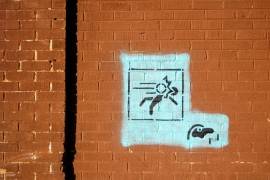 I spent a few weeks trying to get in touch with the person responsible for the penguins around town. I worked through middle-men, friends of friends who might know Paradox. Eventually, I got an email with a phone number to call. Paradox was all too eager to tell his story. Graffiti writing is a lonesome activity, done at night and in silence. And because of the legal issues, artists don’t get to talk about their work much. We set up a time to meet at a friend’s house.
I spent a few weeks trying to get in touch with the person responsible for the penguins around town. I worked through middle-men, friends of friends who might know Paradox. Eventually, I got an email with a phone number to call. Paradox was all too eager to tell his story. Graffiti writing is a lonesome activity, done at night and in silence. And because of the legal issues, artists don’t get to talk about their work much. We set up a time to meet at a friend’s house.
Not many people would think of Paradox when they think of the typical graffiti writer. He is tall and skinny like a CG wireframe and he sucks in air through his nose when he laughs. Before he started writing, he had almost no background in art. His stencils don’t follow typical graffiti form either. His tag is simple and his graffiti isn’t meant to be seen by everyone. Some people pass by his work every day and never notice it, he says.
His main character is the penguin. He also just started tagging a close-up of a face in a gas-mask and a hood — his self portrait. And he tags art based off of “Portal,” Valve’s cult game. He’ll do a stick figure being pummeled by power balls or a cake with the tag line “the cake is a lie.”
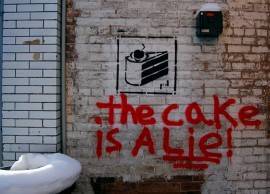 “I don’t play games very often. [Portal] is like the only game I play. It changed the way I look at games just in the way they innovated,” Paradox says.
“I don’t play games very often. [Portal] is like the only game I play. It changed the way I look at games just in the way they innovated,” Paradox says.
Within the graffiti world stencils are still somewhat controversial. Because of the nature of the art form, Graffiti is constantly reinventing itself. Over the last decade, artists like Banksy and Shepard Fairey have changed graffiti from a tag based art to a stencil and sticker form. Some taggers don’t much like the change.
Modern graffiti started in New York in the late 70s and early 80s. Most writers just wanted their names to be seen as much as possible. The idea came from a place of poverty. Writers were nobody until their name got famous. It was a way for kids to feel important, to leave their mark. The art grew up with a working class mentality, dedication and risk. Writers were out every night tagging their name and getting caught by the police. Over the years, taggers designed their pieces to be bigger and more intricate, but the idea of pre-making a tag and quickly posting it was still despised.
Banksy, well known for his stencils lampooning British politics, helped make stencils cool for the non-writing public. His intricate and precise work moved tagging into a more intellectual art form which some writers don’t like. But to the rest of the world, his work is beautiful. His work has something more to say than just “I’m here.” And his chosen medium allows for more thought and quicker results. “Obviously there is a style and techniques that I’ve picked up over the years by people like that,” Paradox says.
Part of his technique is his urban camouflage, what he uses to blend in with his surroundings on a run. When wandering around campus looking for a spot to paint, Paradox pretends to be drunk. If someone asks why he’s in an alley he acts lost. He folds his stencils into fourths so they fit in a pizza box lined with wax paper, mimicking the rest of the campus night life.
“[It] seems like you’re just a drunk guy at 3 a.m. with a pizza, who happens to kind of set it down and pssssshhh [mimes a spray can] and pick it back up,” Paradox says.
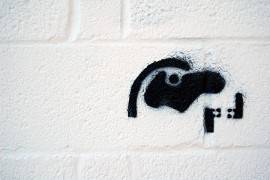 All this stalking around and deception is for a reason. Writers tend to have a complicated set of validations for their art. Paradox says he sees walls as public space that is being overtaken by advertising. The way the public looks at that space, he says, is wrong. Instead of billboards taking over the city walls, everyone should have their chance. He just happens to be the one that takes that chance, almost the Robin Hood of communication.
All this stalking around and deception is for a reason. Writers tend to have a complicated set of validations for their art. Paradox says he sees walls as public space that is being overtaken by advertising. The way the public looks at that space, he says, is wrong. Instead of billboards taking over the city walls, everyone should have their chance. He just happens to be the one that takes that chance, almost the Robin Hood of communication.
“The only difference between what this is [his stencils] and what that is [advertisements] is that they have a lot of money and I painted illegally,” Paradox says.
His motives might be altruistic, but he started, like most other writers, out of boredom. He was up late at night with nothing to do and was looking for some excitement. “I like painting and putting up things and there’s an element of vandalism. I like it,” Paradox says.
Before he started writing, he saw a lot of really interesting pieces painted over, which made him mad. The best piece in town, two life-sized skeletons kissing, was covered up, he says.
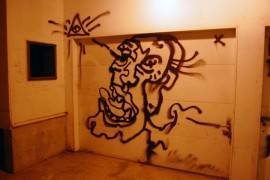
From there he started painting. He stayed with penguins as his mascot because it disarms people who might otherwise get angry. To Paradox, his form of vandalism should be seen as cute. “They know someone had to do it illegally, but when they look at it and see it’s a drawing or a cartoon then they think maybe it’s not so bad,” Paradox says.
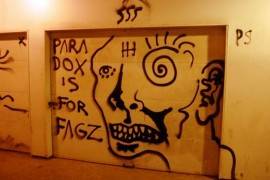 He is conscious of the dangers other than getting caught. Most of the places are blocked off from traffic for a reason, he says. It’s dangerous to climb up fire escapes and run around on a roof. While working on the back of a billboard, a popular place for writers to tag, Paradox fell off the bottom ledge. It wasn’t a long fall, but he felt a crunch and hurt his ankle. He had to stay off it for a few days. “Then [my tag] got painted over. That’s probably the worst thing that happened,” Paradox says.
He is conscious of the dangers other than getting caught. Most of the places are blocked off from traffic for a reason, he says. It’s dangerous to climb up fire escapes and run around on a roof. While working on the back of a billboard, a popular place for writers to tag, Paradox fell off the bottom ledge. It wasn’t a long fall, but he felt a crunch and hurt his ankle. He had to stay off it for a few days. “Then [my tag] got painted over. That’s probably the worst thing that happened,” Paradox says.
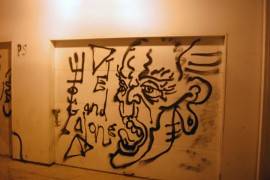 The argument over styles has come to Urbana. Someone going by “Young and Alone” tagged three garage doors with three huge faces (I could not find this person but would love to talk with him/her about the tag). Running from the ground to the ceiling, the faces were artfully sketched with interesting noses and ears, but the can control left something to be desired. There was no stencil work, just a quick free hand. Each face seems to be laughing and the middle one reads, “Paradox is for Fagz,” the first warning shot of things to come.
The argument over styles has come to Urbana. Someone going by “Young and Alone” tagged three garage doors with three huge faces (I could not find this person but would love to talk with him/her about the tag). Running from the ground to the ceiling, the faces were artfully sketched with interesting noses and ears, but the can control left something to be desired. There was no stencil work, just a quick free hand. Each face seems to be laughing and the middle one reads, “Paradox is for Fagz,” the first warning shot of things to come.








